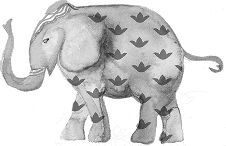T is for Tiipoi
Was creativity a part of your childhood?
Being creative definitely was. But it wasn't structured. I’d just make weird things or do my own science experiments. I liked art materials but I also loved being outside, or in the garden. [As a child] I knew I wanted to do something creative but it was always either around making art or nature related. I liked how things worked. I had lots of questions about the universe. I got really excited about astronomy. I had an obsession about whales. In a way, these things inspired me to always create so I continually made things—paintings and small sculptures. I started taking photos much later.
Can you describe your path to what you’re doing right now?
I don’t think of myself as a designer in a conventional sense. I’ve had the studio for about 3 years now; I think it was incidental to a thought, or perhaps a question I had. The question was very much about the relationship between India and the rest of the world. I guess I felt the most obvious and interesting way for me to explore this would be to create objects that could tell this story. I was just interested in speaking of a parallel or a counter narrative to the usual nostalgia that everything seemed to be drowning in.
Why did Tiipoi come into existence?
Tiipoi is now three years old, and I wanted to address the way Indian objects were received by a Western audience. With all the time I spent in London I felt that it was time another window to India was opened, one that spoke of the common sense attitude to consumption, zero-waste and also how innovation could happen via the lack of something, rather than an excess. I felt that all this was part of the fabric of daily life in India, and the household. It was like thinking of what Muji did for the Japanese way of life, speaking simply.How would you define your brand?
Tiipoi believes in good materials, and that good design is often invisible. Rather than adding to the exploding world of designed products, Tiipoi adapts from existing classics in order to champion lesser known design concepts from the Indian subcontinent. By working with small scale workshops and semi-industrial units, or independent craftsmen and makers, the studio creates designs that brings together handmade and industrial production in India, while always aspiring to keep a human element in the making process. The word Tiipoi comes from ‘tiinpai’, a 3-legged stool that has its colonial origins from the British Raj in India in the late 1800s’. It is assumed that something was lost in translation, as it later came to be referred to as a ‘teapoy’ used as a tea caddy. There is a suspicion that it is because of the ‘Tea’ sound in the word.
How did you develop your aesthetic?
The aesthetic developed quite organically. We didn't know what our collections would look like. We never knew that we wanted to make something look like this or that. We stuck to the brief which was to re-interpret these anonymous objects of the Indian households, that had become ghosts of the past. So ‘re-presenting’ the story of the Indian household was what we wanted to throw light on.
Tons of first hand research went into defining the brand’s design language. We went to India and hung out at all the markets—the metal shops, the utensil shops, we took photos of kitchens and I went on a slightly obsessive spree of going to antique shops and people’s homes and collecting all these things that were used—typically they all belonged to my grandparents generation.
Your design elevate simple Indian objects that over time have gone unnoticed. Is Tiipoi nostalgic in that sense?
No we aren't nostalgic. We don’t want to go back in time. I’m not interested in preservation where it becomes a largely inward and self-involved process. I think it’s important to understand and look at the past, but we need to be in the present too, and the things we make need to reflect that and take into account what’s happening now. I think we are interested to talk about these objects because they have a valid design language that we can appropriate for daily life today, and with regard to revival, I think industrialisation or something changing towards becoming less crafty is not necessarily bad. I think that needs to be a democratic question that is answered directly by the people and the communities who have created the craft—do they want to hold on to it or let go?
What informs your work as a designer?
Well my background is in contemporary art, so I think my brain is semi-wired that way. I get really excited about art. When I go to an exhibition I am completely absorbed by an artist’s practice. I recently saw the work of NY based artist Peter Campus in Paris at the Jeu de Pauem and also the John Latham show at the Serpentine. I love looking at paintings too. I love science. My sister is a scientist so I get to go to her lab and hang out with her while she uses an electron microscope. I also love people’s homes, I like how their environments are paintings of their personalities—the objects they collect, and just assimilating rituals and routines of all kinds.
We all bring ideas to the table, and then we discuss their validity. All our ideas get put through a Tiipoi brief, which essentiality is the test the thing needs to pass if we are to make it. So asking ourselves why we are making it, and also what makes it Tiipoi? We wouldn't make something because it’s easy to make or we can sell thousands off. That’s just filling landfills in the world. So then drawings become models and prototypes and so on.
 What are the tools of your trade?
What are the tools of your trade? Ruler, sketchbook. Whatsapp.
What are your favorite materials to work with?
Copper and Brass I would say.
Are there any specific processes you use in the making of your products?
Metal spinning done in the good old way, by hand.
What are the struggles of following a creative pursuit?
Sticking to your ideas, being true the thing and constantly coming back to it. I feel like lots of designers including us are often faced with ‘oh let’s make this, its really in this season’, I think that’s really not very good place to be. I guess if you follow the money, you are speaking about something else, which is also totally fine, but then you need to be able change your tone and your outlook to completely be that.
I think the world, and the universe will always make space for you if you do something good.
What is design to you?
I think design is something that is omnipresent. There is design in nature, design in a biological cell, design in a plastic bag. I feel like design is a relationship between you and the thing. It’s quite different to art because of the how the object is activated via the user.
Is there such a thing as Indian design?
I think this is a problematic question. I think of course canonically we would need to say this is what makes up Indian design, but I think that’s not a designers job to think about. I think we need to address the brief and the context that is in front of us without really thinking about bringing who we are into the thing actively, I feel that that happens unconsciously if we allow it. I feel indian design can be spoken about, but we need to have more exhibitions and curators putting together content that is original and looking at the Indian context before we end up defining what it is.
I feel the middle class is the most exciting space in India and I don’t think we need to speed it up anymore than the rate at which this space is growing. I think it’s really exciting, the positivity, the questions and the outlook. This is the space that I hope designers will start to fill. I think there are too many expensive objects just sitting in galleries and hotels.Do you think there are enough creative voices out there changing the design landscape?
Sure. They are all my friends, and I’m happy to be part of this little club. Aman Khanna who makes those ugly clay things you see everywhere, Nitin and Disney from Matterial/Immaterial, Ishaan Khosla who’s doing really cool things with his type craft project, Chinar Farooqi from Injiri, Sanket Avlani from Taxi Project, and Ajay Shah from Rubberband.
I think we are brave in some way, to be challenging the norm here as specially, where it’s really hard to pin yourself against the big Scandinavian brands who have schools, icons and embassies supporting their cause. I think we are really stretching ourselves all the time with regard to what we are doing besides making sellable things. So curating exhibitions, doing talks, making films and getting involved with young designers is what we do to contribute.























 GET IN TOUCH
GET IN TOUCH